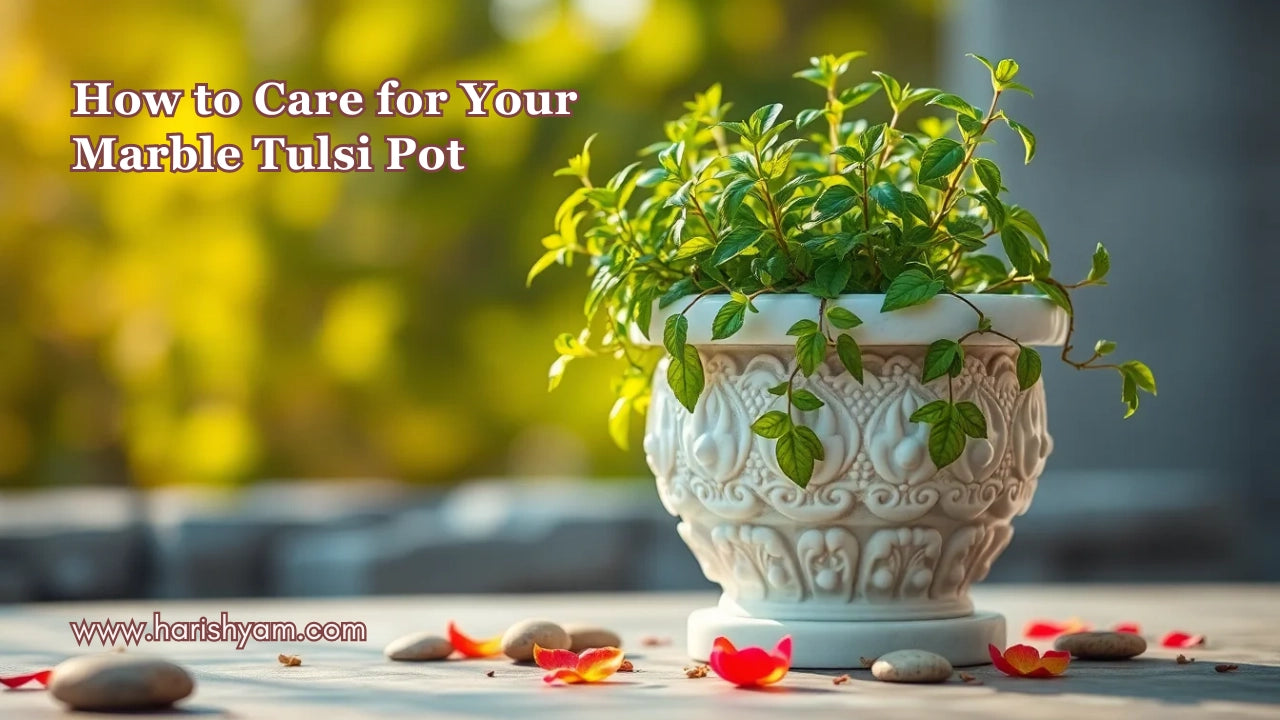Harishyam Arts Blog
Preserving the Beauty of Your Marble Tulsi Pot: A Comprehensive Guide
By HARISHYAM ARTS | On 09 October, 2024 | Views

In the heart of Indian culture, the sacred Tulsi plant holds a revered place, symbolizing purity, devotion, and spiritual well-being. For centuries, devotees have cherished the tradition of housing this beloved herb in beautifully crafted marble pots, creating a harmonious union of nature and artistry. As the owner of a marble Tulsi pot, you have the privilege of nurturing this sacred plant and showcasing its timeless elegance within your home. However, maintaining the pristine condition of your marble planter requires a thoughtful approach.
In this comprehensive guide, we will delve into the art of caring for your marble Tulsi pot, ensuring it remains a stunning centerpiece in your living space for years to come.
Understanding the Allure of Marble Tulsi Pots
Marble, a natural stone renowned for its exquisite beauty and durability, has long been the material of choice for housing the Tulsi plant. Its smooth, cool surface not only complements the vibrant green foliage but also provides an ideal environment for the plant to thrive. The inherent properties of marble, such as its resistance to weathering and its ability to retain temperature, make it an exceptional choice for cultivating this sacred herb.
Moreover, the timeless elegance of marble Tulsi pots has cemented their status as cherished heirlooms, passed down through generations. These vessels become more than just a container for the plant; they become a canvas for intricate carvings, intricate designs, and cultural motifs that elevate the entire display.
Daily Care for Your Marble Tulsi Pot
Maintaining the pristine condition of your marble Tulsi pot requires a consistent and mindful approach. Let's explore the essential steps to ensure your planter remains in optimal condition.
Watering Practices
Tulsi plants thrive in well-drained soil, and the same principle applies to your marble pot. Avoid overwatering, as excess moisture can lead to the development of mold or mildew, which can discolor the marble surface. Instead, water your Tulsi plant only when the soil feels slightly dry to the touch, taking care not to let the soil become completely parched.
Sunlight Exposure
Tulsi plants require ample sunlight to flourish, and your marble pot should be placed in a location that receives at least 6 hours of direct sunlight per day. However, be mindful of the marble's sensitivity to prolonged UV exposure, which can cause discoloration over time. Consider positioning your planter in a spot that offers a balance of sunlight and shade throughout the day.
Temperature Considerations
Marble is a material that is sensitive to extreme temperature fluctuations. Avoid placing your Tulsi pot in direct sunlight during the hottest hours of the day or near sources of intense heat, as this can lead to cracking or warping of the marble. Likewise, protect your planter from freezing temperatures during the winter months to prevent damage.
Cleaning Your Marble Tulsi Pot
Proper cleaning techniques are essential to maintaining the pristine appearance of your marble Tulsi pot. Regular maintenance will not only preserve the marble's luster but also prevent the buildup of stains and mineral deposits.
Regular Cleaning
Gently wipe down the exterior of your marble pot with a soft, damp cloth, taking care to avoid any abrasive materials that could scratch the surface. For a more thorough cleaning, use a mild, pH-neutral soap and warm water, followed by a gentle scrubbing with a soft-bristled brush. Rinse the pot thoroughly and dry it with a clean, soft towel.
Dealing with Stains
If you encounter stubborn stains or discoloration on your marble Tulsi pot, a mixture of warm water and a small amount of mild detergent or baking soda can be an effective solution. Gently scrub the affected area with a soft-bristled brush, taking care not to apply too much pressure. Rinse the pot thoroughly and dry it completely.
Avoiding Harsh Chemicals
It is crucial to avoid using harsh chemicals, such as acidic cleaners or abrasive scrubbers, on your marble Tulsi pot. These can etch the surface, leading to permanent damage and discoloration. Stick to gentle, pH-neutral cleaning products specifically formulated for use on marble surfaces.
Protecting Your Marble Tulsi Pot
To ensure the longevity and beauty of your marble Tulsi pot, it is essential to take proactive measures to protect it from potential damage.
Sealing the Marble
Applying a marble sealant can help create a protective barrier against stains, scratches, and other forms of wear and tear. This sealant should be reapplied periodically, following the manufacturer's instructions, to maintain the effectiveness of the protection.
Preventing Scratches and Chips
Marble is a relatively soft stone, making it susceptible to scratches and chips. Avoid placing heavy objects directly on the surface of your Tulsi pot, and be mindful when moving or repositioning the planter. Consider using coasters or felt pads to protect the bottom of the pot from any surface it may be placed on.
Handling with Care
When moving or cleaning your marble Tulsi pot, always lift it from the bottom, rather than gripping the sides or rim. This will help prevent cracks or chips from forming. Additionally, avoid subjecting the pot to sudden temperature changes, as this can cause the marble to expand or contract, leading to structural damage.
Maintaining the Tulsi Plant in Your Marble Pot
Caring for the Tulsi plant itself is just as crucial as maintaining the marble pot. Ensure the plant's optimal growth and longevity by following these guidelines.
Proper Soil and Drainage
Use a well-draining, nutrient-rich potting mix specifically formulated for Tulsi plants. Ensure the pot has adequate drainage holes to prevent waterlogging, which can lead to root rot and other issues.
Pruning and Trimming
Regular pruning and trimming of the Tulsi plant will encourage bushy growth and prevent the plant from becoming leggy or overgrown. Gently trim any dead or damaged leaves or stems, taking care not to damage the plant's delicate structure.
Fertilizing Guidelines
Tulsi plants benefit from a balanced, organic fertilizer applied every few months during the growing season. Avoid using chemical-based fertilizers, as they can potentially damage the marble surface over time.
Troubleshooting Common Issues
Even with the best care, you may encounter occasional challenges with your marble Tulsi pot. Here are some common issues and how to address them.
Addressing Discoloration
If you notice discoloration or staining on the marble surface, try a gentle cleaning solution of warm water and a small amount of mild detergent or baking soda. Avoid using harsh chemicals or abrasives, as these can further damage the marble.
Repairing Minor Damages
For minor chips or cracks in the marble, you can use a marble repair epoxy or filler to restore the surface. Be sure to follow the manufacturer's instructions carefully and allow the repair to fully cure before using the pot again.
Dealing with Mineral Deposits
Over time, mineral deposits from the water used to care for your Tulsi plant may accumulate on the marble surface. These can be removed using a mixture of warm water and white vinegar, gently scrubbing with a soft-bristled brush.
Seasonal Care Tips
Adapting your marble Tulsi pot care routine to the changing seasons can help ensure the long-term health and beauty of your planter.
Summer Care
During the hot summer months, be extra vigilant about watering your Tulsi plant, as the soil may dry out more quickly. Avoid placing the pot in direct sunlight for extended periods, and consider moving it to a shaded area if the temperatures become too intense.
Winter Protection
As the temperatures drop, protect your marble Tulsi pot from freezing conditions. If possible, move the pot indoors or to a sheltered location, and reduce watering to prevent waterlogging and potential cracking of the marble.
Monsoon Considerations
During the monsoon season, be mindful of excess moisture and humidity. Ensure proper drainage to prevent waterlogging, and consider using a mild fungicide to prevent the growth of mold or mildew on the marble surface.
Enhancing Your Home with a Marble Tulsi Pot
Beyond its functional purpose, a well-maintained marble Tulsi pot can become a stunning focal point in your living space, elevating the overall aesthetic and infusing your home with a sense of cultural richness.
Placement Ideas
Position your marble Tulsi pot in a prominent location, such as a windowsill, entryway, or living room, where it can be admired and appreciated. Consider pairing it with complementary decor elements, such as brass or copper accents, to create a harmonious visual display.
Complementary Decor
Incorporate other traditional Indian elements, such as brass diyas, incense holders, or decorative trays, to create a cohesive and visually striking arrangement around your marble Tulsi pot. This can help to enhance the cultural significance and aesthetic appeal of your sacred planter.
Conclusion
Caring for your marble Tulsi pot is a labor of love, one that allows you to preserve the timeless beauty and cultural significance of this revered tradition. By following the comprehensive guidelines outlined in this guide, you can ensure your marble planter remains a stunning centerpiece in your home for years to come. Embrace the ritual of nurturing your Tulsi plant and the marble vessel that houses it, and let it become a source of inspiration, serenity, and connection to your cultural heritage.
In the heart of Indian culture, the sacred Tulsi plant holds a revered place, symbolizing purity, devotion, and spiritual well-being. For centuries, devotees have cherished the tradition of housing this beloved herb in beautifully crafted marble pots, creating a harmonious union of nature and artistry. As the owner of a...

HARISHYAM ARTS
I’m Lakshay Sharma, a writer with a deep passion for Hindu mythology, Vastu Shastra, and home interiors. I enjoy exploring the rich traditions of Hindu gods and goddesses, sharing insights into Vastu principles, and offering guidance on creating sacred spaces like Puja Mandirs. Through my writing, I aim to inspire harmony and spiritual well-being, blending traditional knowledge with modern perspectives.
Harishyam Arts | Jaipur
Related Blogs

How to Choose Classic Wooden Temple Furniture That Lasts Generations
Lakshay Sharma | December 08, 2025
A temple at home is not just a space for devotion; it is a sanctuary that refl...
Read More...
How Different Woods Affect Religious Statue Quality: Teak, Sheesham, Sandalwood, and More
Lakshay Sharma | December 07, 2025
Artistry in religious statues is not just about skill or devotion—it is also d...
Read More...
Guide to Inlay, Meenakari and Gold Leaf Work on Marble Idols
Lakshay Sharma | December 06, 2025
Marble has been cherished for centuries for its timeless beauty, durability, a...
Read More...
Brass Idols vs. Other Materials: Comparing Durability, Look, and Spiritual Aura
Lakshay Sharma | December 05, 2025
In the world of sacred art and worship, the material chosen for an idol or mur...
Read More...
Makar Sankranti 2026: Date, Significance, Puja Method, and Celebration Tips
Lakshay Sharma | December 04, 2025
Makar Sankranti is one of the most awaited festivals in India, celebrated with...
Read More...
Teak Wood, Sheesham and MDF for Mandirs: Pros and Cons Explained
Lakshay Sharma | December 03, 2025
Choosing the right material for your home mandir is an important decision—one ...
Read More...
First-Time Buyer Guide to Ordering Custom Marble Murtis Online from Jaipur
Lakshay Sharma | December 02, 2025
Why Jaipur Is Famous for Marble Murtis
Jaipur ...
Read More...
Why Carved Teak Wood Furniture Is Making a Comeback in Indian Homes
Lakshay Sharma | December 01, 2025
Indian homes have always embraced tradition, craftsmanship, and timeless beaut...
Read More...
How to Choose the Ideal Pooja Mandir for Your Home: Material, Size, and Style
Lakshay Sharma | November 30, 2025
A pooja mandir is the sacred heart of every Indian home, where spirituality me...
Read More...Who is Ghantaghar Mahavir Swami? The Spiritual Legacy Behind the Iconic Name
Lakshay Sharma | November 29, 2025
The term “Ghantaghar Mahavir Swami” refers to the di...
Read More...
Guidelines for gifting god idols to others
Lakshay Sharma | November 28, 2025
Gifting a God idol is considered a highly auspicious act in Indian tradition. ...
Read More...
What happens if God idol breaks by mistake
Lakshay Sharma | November 27, 2025
God idols represent purity, devotion, and divine energy in every Hindu home. W...
Read More...
Mixing Materials: Marble Mandirs with Wooden, Brass, or Metal Accents
Lakshay Sharma | November 26, 2025
Combining marble with wooden, brass, or metal accents transforms a simple mand...
Read More...
Step-by-Step Guide to Professional Marble Statue Repainting
Lakshay Sharma | November 24, 2025
Marble statues are timeless masterpieces that reflect devotion, beauty, and cr...
Read More...
Is It Okay to Hang a Mandir on a Wall? A Complete Guide to Wall-Mounted Temples
Lakshay Sharma | November 23, 2025
In today’s fast-paced world, where urban homes are becoming more compact and s...
Read More...
Who is Parashvanath? The Life and Legacy of Jainism’s 23rd Tirthankara
Lakshay Sharma | November 22, 2025
Faith and spirituality are cornerstones of Indian tradition, and Jainism stand...
Read More...
How to Choose Between Carved and Minimalistic Wooden Mandirs
Lakshay Sharma | November 21, 2025
A home mandir (temple) is far more than just a piece of furniture; it is the s...
Read More...
How to clean silver god idols at home
Lakshay Sharma | November 21, 2025
At Harishyam Arts, we understand the spiritual and aesthetic significance of s...
Read More...
Are Marble Dust Statues Ideal for Your Home Temple? Pros & Cons
Lakshay Sharma | November 19, 2025
When it comes to selecting statues for your home temple, marble dust statues h...
Read More...
Where to Buy Authentic Marble Gods' Moortis in the USA: A Guide for Devotees and Collectors
Lakshay Sharma | November 19, 2025
For devotees and collectors in the USA seeking authentic marble Hindu god moor...
Read More...
Maa Parvati 108 Names in Sanskrit and English: Their Significance, Meaning, and Mantra Power
Lakshay Sharma | November 17, 2025
The Divine Essence of Maa Parvati
Maa Parvati,...
Read More...
8 Guidelines for Setting Up Your Home Mandir with Wooden Murtis: Location, Selection, and Maintenance.
Lakshay Sharma | November 16, 2025
Introduction: The Divine Mother of Strength and Compassion

Who Was Jain Mahavir? The Life, Teachings, and Legacy of the 24th Tirthankara
Lakshay Sharma | November 15, 2025
Lord Mahavir, the 24th Tirthankara of Jainism, was a spiritual reformer who re...
Read More...
Benefits of Choosing Corian Mandirs Over Marble and Wood
Lakshay Sharma | November 14, 2025
Modern homes today demand elegance, functionality, and easy upkeep — and Coria...
Read More...
White vs. Black Shivling: Which One Is Best for Your Home and Why?
Lakshay Sharma | November 13, 2025
The Shivling, a sacred symbol of Lord Shiva, embodies creation, power, and pur...
Read More...
10 Stunning Marble Handicraft Pieces to Elevate Your Home Décor
Lakshay Sharma | November 12, 2025
Marble handicrafts represent timeless artistry, luxury, and devotion. At Haris...
Read More...
Brass Ganesha Idols as Gifts: Symbolism, Occasions, and Gifting Etiquette
Lakshay Sharma | November 11, 2025
Gifting a brass Ganesha idol is more than a gesture—it's a blessing of prosper...
Read More...
Luxury Kids Room Decor Ideas That Turn Every Space Into a Fairytale Dream
Lakshay Sharma | November 10, 2025
Transforming a child’s room into a luxury fairytale dream combines comfort wit...
Read More...
Why Repainting Your Marble Statue Can Extend Its Life and Beauty
Lakshay Sharma | November 09, 2025
Marble statues are elegant pieces of art that add charm to any home or temple....
Read More...
How to Choose the Perfect Wall-Mounted Wooden Mandir for Your Home
Lakshay Sharma | November 08, 2025
A wall-mounted wooden mandir is more than just a spiritual corner; it’s a blen...
Read More...
Understanding GST on Marble God Statues: A Complete Guide for Buyers and Sellers
Lakshay Sharma | November 07, 2025
Marble god statues are a popular choice for temples, homes, and offices due to...
Read More...
Are Wooden Statues Pest-Resistant? How to Protect Your Wooden Idols from Insects and Damage
Lakshay Sharma | November 06, 2025
Wooden statues have been cherished for centuries due to their natural beauty a...
Read More...
Corian vs Wooden Temples: Which One Should You Choose?
Lakshay Sharma | November 05, 2025
Choosing the perfect temple for your home is more than just selecting a design...
Read More...
How Customised Marble Human Bust Manufacturers Bring Personalities to Life
Lakshay Sharma | November 04, 2025
Crafting a marble human bust is so much more than sculpting a likeness—it's ab...
Read More...
The Power of the Hare Krishna Maha Mantra: Awakening Spiritual Bliss
Lakshay Sharma | November 03, 2025
The Hare Krishna Maha Mantra is a sacred chant that ...
Read More...
The 24 Tirthankaras of Jainism: Names, Symbols, and Significance
Lakshay Sharma | November 02, 2025
In Jainism, the Tirthankaras are revered as divine s...
Read More...
Top 25 Space-Saving Wooden Mandir Ideas for Modern Homes
Lakshay Sharma | November 01, 2025
A pooja mandir is the heart of every Indian home — a sacred corner where peace...
Read More...
What Are the 8 Forms of Lakshmi? | Ashta Lakshmi Meaning and Significance
Lakshay Sharma | October 31, 2025
The Divine Essence of Goddess Lakshmi
Goddess La...
Read More...
The Art of Craftsmanship: How Handmade Brass Statues Are Created
Lakshay Sharma | October 30, 2025
At Harishyam Arts, we celebrate the timeless beauty ...
Read More...
How to Dispose of Broken Marble God Murti
Lakshay Sharma | October 30, 2025
In Hindu tradition, marble murtis represent divine presence and spiritual ener...
Read More...
Wooden Statues vs Marble Statues: Which One Should You Choose?
Lakshay Sharma | October 29, 2025
When it comes to decorating your home or creating a sacred space, choosing the...
Read More...
How a Wooden Temple Enhances Positive Energy in Your Home
Lakshay Sharma | October 28, 2025
A home temple isn’t just a decorative corner — it’s the spiritual...
Read More...
Why Lord Krishna is Worshipped in Different Forms Across India
Lakshay Sharma | October 27, 2025
Lord Krishna — the eighth incarnation of Lord Vishnu — is one of the most belo...
Read More...
The Story of Goddess Saraswati: The Embodiment of Wisdom and Knowledge
Lakshay Sharma | October 26, 2025
Among the many deities of the Hindu pantheon, Maa Saraswati Read More...

Top Reasons to Choose Brass Statues for Home Décor and Spiritual Spaces
Lakshay Sharma | October 25, 2025
Home décor today is not only about beauty—it’s about creating a peaceful and m...
Read More...
How long do Corian temples last?
Lakshay Sharma | October 24, 2025
Choosing the right material for a temple at home is important for both aesthet...
Read More...
Why Lord Shiva is Called the Mahadeva – The Supreme God
Lakshay Sharma | October 23, 2025
Hinduism, one of the world’s oldest religions, has a rich pantheon of deities,...
Read More...
Why Corian Temples Are Becoming Popular in Contemporary Homes
Lakshay Sharma | October 22, 2025
In today’s modern homes, interior décor blends tradition with contemporary sty...
Read More...
Dome or No Dome? Choosing the Right Design for Your Home Temple
Lakshay Sharma | October 21, 2025
Creating a sacred space at home is a spiritual investment, and the design of y...
Read More...
Traditional vs Modern Wooden Temples: Which Suits Your Space?
Lakshay Sharma | October 20, 2025
Creating a sacred space in your home is more than just interior décor — it’s a...
Read More...



